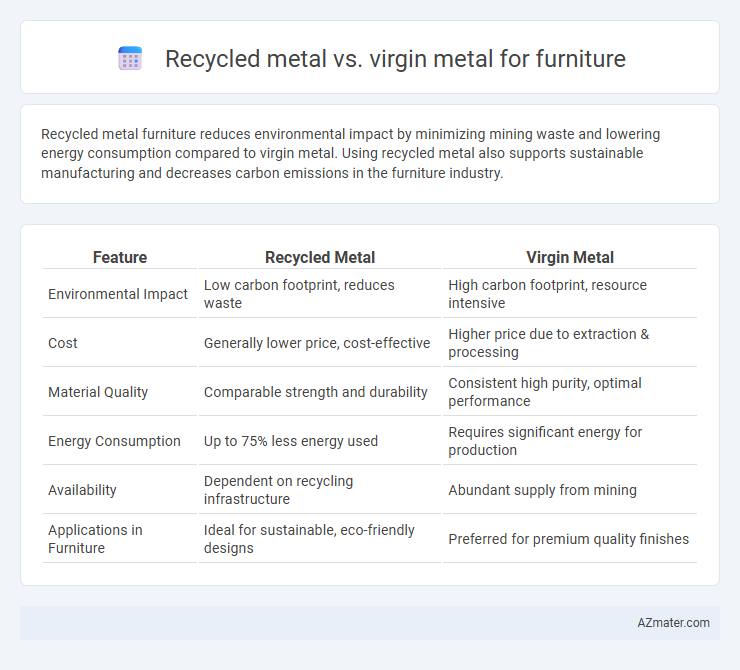Recycled metal furniture reduces environmental impact by minimizing mining waste and lowering energy consumption compared to virgin metal. Using recycled metal also supports sustainable manufacturing and decreases carbon emissions in the furniture industry.
Table of Comparison
| Feature | Recycled Metal | Virgin Metal |
|---|---|---|
| Environmental Impact | Low carbon footprint, reduces waste | High carbon footprint, resource intensive |
| Cost | Generally lower price, cost-effective | Higher price due to extraction & processing |
| Material Quality | Comparable strength and durability | Consistent high purity, optimal performance |
| Energy Consumption | Up to 75% less energy used | Requires significant energy for production |
| Availability | Dependent on recycling infrastructure | Abundant supply from mining |
| Applications in Furniture | Ideal for sustainable, eco-friendly designs | Preferred for premium quality finishes |
Environmental Impact: Recycled Metal vs Virgin Metal
Recycled metal significantly reduces environmental impact by lowering energy consumption and decreasing greenhouse gas emissions compared to virgin metal extraction and processing. Virgin metal production involves extensive mining, leading to habitat destruction, soil erosion, and increased carbon footprint due to high-temperature smelting processes. Utilizing recycled metal in furniture manufacturing conserves natural resources, minimizes landfill waste, and supports sustainable circular economy practices.
Resource Efficiency and Sustainability
Recycled metal significantly reduces energy consumption by up to 95% compared to processing virgin metal, enhancing resource efficiency in furniture manufacturing. Utilizing recycled metal decreases raw material extraction, lowering environmental degradation and conserving finite natural resources. Furniture made with recycled metal contributes to sustainability by minimizing carbon emissions and supporting circular economy principles.
Energy Consumption in Metal Production
Recycled metal significantly reduces energy consumption compared to virgin metal production, often saving up to 95% of the energy required for extraction and refining. The furniture industry benefits from using recycled metals like aluminum and steel, which demand less energy-intensive processes, lowering carbon footprints. Energy-efficient metal recycling supports sustainable furniture manufacturing by conserving natural resources and minimizing greenhouse gas emissions.
Cost Comparison: Recycled vs Virgin Metal
Recycled metal furniture typically costs 15-30% less than virgin metal due to reduced energy consumption and lower raw material expenses. Virgin metal prices fluctuate with mining costs, energy prices, and market demand, often resulting in higher production costs compared to recycled metal. Using recycled metal also helps manufacturers avoid fees related to environmental compliance and waste disposal, further decreasing overall expenses.
Quality and Durability Differences
Recycled metal for furniture retains high structural integrity but may exhibit minor variations in alloy composition compared to virgin metal, which is typically purer and more consistent in quality. Virgin metal often offers superior durability under extreme stress or environmental exposure due to its unaltered molecular structure, while recycled metal's strength largely depends on the recycling process and quality control. Both materials can achieve comparable longevity in furniture applications when properly treated and manufactured, with recycled metal providing an eco-friendly alternative without significant sacrifice in performance.
Design Flexibility and Aesthetics
Recycled metal offers enhanced design flexibility for furniture due to its ability to be easily reshaped and molded without compromising structural integrity, enabling innovative and customizable designs. Virgin metal provides a consistent and uniform finish, ideal for high-end aesthetics where flawless surface quality and pristine appearance are critical. Selecting recycled metal supports sustainable design practices while allowing for creative expression through varied textures and finishes in modern furniture production.
Supply Chain and Material Availability
Recycled metal offers a more sustainable and often more reliable supply chain for furniture manufacturing due to its reduced dependency on raw ore extraction and lower energy consumption during processing. Virgin metal supply chains are subject to geopolitical tensions, mining restrictions, and environmental regulations that can cause volatility in availability and prices. The growing demand for eco-friendly furniture accelerates the adoption of recycled metals, ensuring a more consistent material supply by utilizing scrap metal and reducing reliance on finite natural resources.
Certifications and Standards for Furniture Metals
Recycled metals used in furniture often comply with environmental certifications like the Cradle to Cradle Certified(tm) and ISO 14001, ensuring sustainable sourcing and reduced ecological impact. Virgin metals adhere to standards such as ASTM International and the International Organization for Standardization (ISO) 9001, guaranteeing consistent strength and durability in structural applications. Both recycled and virgin metals meet regulatory criteria, but recycled metals emphasize eco-friendly certifications that support green building initiatives and circular economy principles.
Consumer Perception and Market Trends
Consumer perception increasingly favors recycled metal in furniture due to its environmental benefits and sustainability credentials, aligning with growing eco-conscious market trends. Market data reveals a significant rise in demand for recycled metal furniture, driven by younger demographics prioritizing green products. Despite slightly higher costs, recycled metal appeals to consumers seeking ethical manufacturing and reduced carbon footprints.
Future Outlook: Innovations in Metal Furniture Production
Advancements in recycled metal processing are driving innovations in metal furniture production, enabling manufacturers to create durable, eco-friendly designs with lower carbon footprints compared to virgin metal. Emerging technologies such as 3D printing and alloy refinement optimize recycled metal's strength and versatility, enhancing customization and sustainability. Increased consumer demand for circular economy products encourages the industry to adopt recycled metals, promising a future where furniture combines environmental responsibility with cutting-edge design.

Infographic: Recycled metal vs Virgin metal for Furniture
 azmater.com
azmater.com